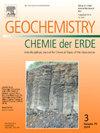Analysis of clustering methods for geochemical anomaly identification through weighted sample catchment basins
IF 2.9
3区 地球科学
Q2 GEOCHEMISTRY & GEOPHYSICS
引用次数: 0
Abstract
The cruciality of geochemical exploration in discovering new mineral deposits demands the use of high-performance computational techniques to recognize geochemical anomaly patterns associated with mineralization. High dimensionality and complexity of geochemical datasets lead to use of brand-new methods including machine learning tools to get more efficient and accurate outcome. In this regard, advanced clustering methods have gained significant popularity over the years in the field of mineral exploration. This study presents an integrated mineral exploration approach using multiple clustering algorithms to identify Cu mineralization potential in the Kariz-Now district, Razavi Khorasan, northeastern Iran. The methodology uses faults within the study area to weight the catchment basins and brings grade characteristics of role-playing elements along with fault weights to highlight the potential areas. Three clustering techniques including K-Means (KM), Fuzzy C-Means (FCM), and DBSCAN were applied to the variables attached to their corresponding sample catchment basins to predict potential areas. The results were validated by success rate curves of the selected methods and the area under curve was calculated. The results reveal that DBSCAN has higher area under curve (AUC) than KM and FCM. Furthermore, there is a strong correlation between predicted anomalies and Paleogene volcanic and sedimentary rocks, particularly in areas with high fault density.
集水区加权样本地球化学异常识别聚类方法分析
地球化学勘探在发现新矿床中的重要性要求使用高性能计算技术来识别与成矿有关的地球化学异常模式。地球化学数据集的高维性和复杂性导致使用包括机器学习工具在内的全新方法来获得更高效和准确的结果。在这方面,先进的聚类方法多年来在矿产勘查领域得到了很大的普及。本研究提出了一种综合矿产勘探方法,使用多聚类算法来识别伊朗东北部Razavi Khorasan Kariz-Now地区的铜成矿潜力。该方法利用研究区内的断层对流域进行加权,并结合角色扮演元素的品位特征和断层权重来突出潜在区域。将K-Means (KM)、模糊C-Means (FCM)和DBSCAN三种聚类技术应用于相应样本流域的变量,以预测潜在面积。通过所选方法的成功率曲线对结果进行验证,并计算曲线下面积。结果表明,DBSCAN的曲线下面积(AUC)高于KM和FCM。此外,预测异常与古近系火山岩和沉积岩具有很强的相关性,特别是在断层密度高的地区。
本文章由计算机程序翻译,如有差异,请以英文原文为准。
求助全文
约1分钟内获得全文
求助全文
来源期刊

Chemie Der Erde-Geochemistry
地学-地球化学与地球物理
CiteScore
7.10
自引率
0.00%
发文量
40
审稿时长
3.0 months
期刊介绍:
GEOCHEMISTRY was founded as Chemie der Erde 1914 in Jena, and, hence, is one of the oldest journals for geochemistry-related topics.
GEOCHEMISTRY (formerly Chemie der Erde / Geochemistry) publishes original research papers, short communications, reviews of selected topics, and high-class invited review articles addressed at broad geosciences audience. Publications dealing with interdisciplinary questions are particularly welcome. Young scientists are especially encouraged to submit their work. Contributions will be published exclusively in English. The journal, through very personalized consultation and its worldwide distribution, offers entry into the world of international scientific communication, and promotes interdisciplinary discussion on chemical problems in a broad spectrum of geosciences.
The following topics are covered by the expertise of the members of the editorial board (see below):
-cosmochemistry, meteoritics-
igneous, metamorphic, and sedimentary petrology-
volcanology-
low & high temperature geochemistry-
experimental - theoretical - field related studies-
mineralogy - crystallography-
environmental geosciences-
archaeometry
 求助内容:
求助内容: 应助结果提醒方式:
应助结果提醒方式:


